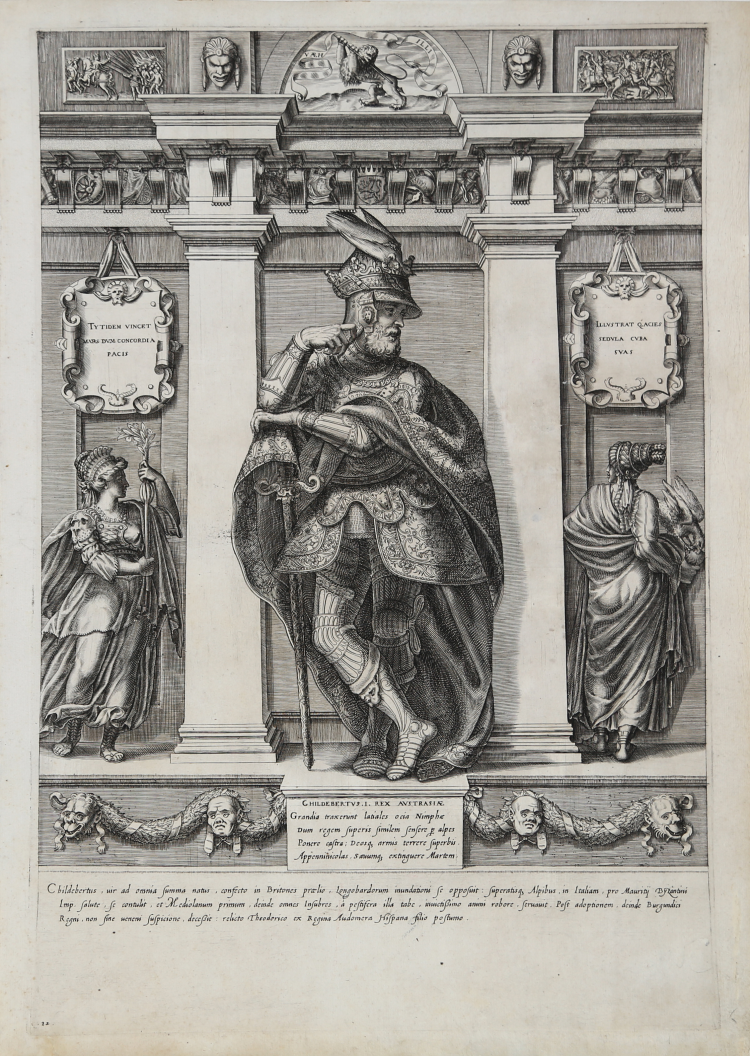



| Reference: | S45112 |
| Author | Gaspare OSELLI detto "Gaspare degli Uccelli" |
| Year: | 1557 ca. |
| Measures: | 360 x 525 mm |


| Reference: | S45112 |
| Author | Gaspare OSELLI detto "Gaspare degli Uccelli" |
| Year: | 1557 ca. |
| Measures: | 360 x 525 mm |
Portrait of Childebert I. Etching and engraving, ca. 1557, unsigned.
Beautiful proof, impressed on contemporary laid paper, with margins, in good condition.
The plate belongs to the famous series Francisci Tertii Bergomatis Serenissimi Ferdinandi Archiducis Austriæ Ducis Borgundiæ Comitis Tirolis Etc. Pictoris Aulici ad Invictiss Caesarem Maximilianum II. Romanorum Imp. Semper Augustum. Austriacæ Gentis Imaginum engraved by Gaspare Oselli from the drawings of Francesco Terzi. The series, divided into five parts, each preceded by a frontispiece, features full-length engraving of 74 members of the House of Austria accompanied by explanatory captions about the lives of individual characters and often also symbolic-allegorical depictions.
The collection Austriacae gentis imagines consists of a series of portraits, 57 plates in all, plus the final page. Seventy-four full-length members of the Habsburg family are depicted in the series. The figures are inserted, like statues, into complex architectural structures and wear rich robes. On the sides of the niches that accommodate said figures emerge allegorical scenes, masks and other decorative friezes.
Gian Francesco Terzi or Tertius, a painter from Bergamo, is the originator of the subjects, and in executing the designs, he made use of various models, both pictorial and sculptural, inspired mainly by the bronze sculptures that surround and adorn the cenotaph of Emperor Maximilian I in the Hofkirche in Innsbruck. Some portraits faithfully reproduce the bronze statues in Innsbruck, others differ, Terzi created the work to show his gratitude to the Habsburgs, at that time great patrons of the arts and a family for whom he had worked for a long time.
The subjects seem at first glance to be very similar to each other; however, on close inspection they each reveal their own peculiarities. They are works undoubtedly of great artistic value, but also and above all of historical value, since they depict members of one of the European dynasties that marked the history of the time.
Bibliografia
G. Streliotto, Gaspar ab Avibus incisore cittadellese del XVI secolo, pp. 44-126; S. Seccareccia, La serie delle "Austriacae gentis Imagines" di Gaspare Osello (prima parte), in "Rassegna di Studi e di Notizie", Vol. XXII, a. XXV, Milano 1998, pp. 403-420 n. 1-10, figg. 1-10; S. Seccareccia, La serie delle "Austriacae Gentis Imagines" di Gaspare Osello (seconda parte), in "Rassegna di Studi e di Notizie", Vol. XXIII, a. XXVI, Milano 1999, pp. 179-222; Michael Bury in “Print Quarterly” XXIX 2012, p. 420; Paisey 2002, Catalogue of German printed books to 1900 (375).
Gaspare OSELLI detto "Gaspare degli Uccelli"
|
Although Gandellini wants him to be flourishing in 1577 and Basan qualifies him as Cesare de Avìbus and more often Cesar patavinus making him born in 1645 it constitutes on the other hand from incontrovertible evidence and from repeated legends affixed in various of his works that only around the year 1536 was he born in Cittadella and not Padua and that initiated at the school of Mantuan Giorgio Glusi in a short time he rivalled him in the handling of engraving His main prints in fact bear the date from 1560 to 1580 and are signed in different manners: Gaspar patavinus; Gaspar ab Avibus Citadelensis; Gasparo Oselle padovano; etc. In the style of the Sadelers he then carved in 72 pieces the portraits of the princes of the house of Austria for V by Francesco Terzi l of Bergamo, where in addition to a particular display of architecture there is a bizarre and magnificent grafting of sumptuous draperies of armor and emblems (N. Pietrucci, Biografia degli artisti Padovani).
|
Gaspare OSELLI detto "Gaspare degli Uccelli"
|
Although Gandellini wants him to be flourishing in 1577 and Basan qualifies him as Cesare de Avìbus and more often Cesar patavinus making him born in 1645 it constitutes on the other hand from incontrovertible evidence and from repeated legends affixed in various of his works that only around the year 1536 was he born in Cittadella and not Padua and that initiated at the school of Mantuan Giorgio Glusi in a short time he rivalled him in the handling of engraving His main prints in fact bear the date from 1560 to 1580 and are signed in different manners: Gaspar patavinus; Gaspar ab Avibus Citadelensis; Gasparo Oselle padovano; etc. In the style of the Sadelers he then carved in 72 pieces the portraits of the princes of the house of Austria for V by Francesco Terzi l of Bergamo, where in addition to a particular display of architecture there is a bizarre and magnificent grafting of sumptuous draperies of armor and emblems (N. Pietrucci, Biografia degli artisti Padovani).
|